Artículo
Reperfusion arrhythmias increase after superior cervical ganglionectomy due to conduction disorders and changes in repolarization
Prado, Natalia Jorgelina ; Muñoz, Estela Maris
; Muñoz, Estela Maris ; Farías Altamirano, Luz Estefanía
; Farías Altamirano, Luz Estefanía ; Aguiar, Francisco; Ponce Zumino, Amira Zulma
; Aguiar, Francisco; Ponce Zumino, Amira Zulma ; Ruiz Sánchez, Francisco Javier; Miatello, Roberto Miguel
; Ruiz Sánchez, Francisco Javier; Miatello, Roberto Miguel ; Pueyo, Esther; Diez, Emiliano Raúl
; Pueyo, Esther; Diez, Emiliano Raúl
 ; Muñoz, Estela Maris
; Muñoz, Estela Maris ; Farías Altamirano, Luz Estefanía
; Farías Altamirano, Luz Estefanía ; Aguiar, Francisco; Ponce Zumino, Amira Zulma
; Aguiar, Francisco; Ponce Zumino, Amira Zulma ; Ruiz Sánchez, Francisco Javier; Miatello, Roberto Miguel
; Ruiz Sánchez, Francisco Javier; Miatello, Roberto Miguel ; Pueyo, Esther; Diez, Emiliano Raúl
; Pueyo, Esther; Diez, Emiliano Raúl
Fecha de publicación:
03/2020
Editorial:
Molecular Diversity Preservation International
Revista:
International Journal of Molecular Sciences
ISSN:
1422-0067
Idioma:
Inglés
Tipo de recurso:
Artículo publicado
Clasificación temática:
Resumen
Pharmacological concentrations of melatonin reduce reperfusion arrhythmias, but less is known about the antiarrhythmic protection of the physiological circadian rhythm of melatonin. Bilateral surgical removal of the superior cervical ganglia irreversibly suppresses melatonin rhythmicity. This study aimed to analyze the cardiac electrophysiological effects of the loss of melatonin circadian oscillation and the role played by myocardial melatonin membrane receptors, SERCA2A, TNFα, nitrotyrosine, TGFβ, KATP channels, and connexin 43. Three weeks after bilateral removal of the superior cervical ganglia or sham surgery, the hearts were isolated and submitted to ten minutes of regional ischemia followed by ten minutes of reperfusion. Arrhythmias, mainly ventricular tachycardia, increased during reperfusion in the ganglionectomy group. These hearts also suffered an epicardial electrical activation delay that increased during ischemia, action potential alternants, triggered activity, and dispersion of action potential duration. Hearts from ganglionectomized rats showed a reduction of the cardioprotective MT2 receptors, the MT1 receptors, and SERCA2A. Markers of nitroxidative stress (nitrotyrosine), inflammation (TNFα), and fibrosis (TGFβ and vimentin) did not change between groups. Connexin 43 lateralization and the pore-forming subunit (Kir6.1) of KATP channels increased in the experimental group. We conclude that the loss of the circadian rhythm of melatonin predisposes the heart to suffer cardiac arrhythmias, mainly ventricular tachycardia, due to conduction disorders and changes in repolarization.
Archivos asociados
Licencia
Identificadores
Colecciones
Articulos(IHEM)
Articulos de INST. HISTOLOGIA Y EMBRIOLOGIA DE MEND DR.M.BURGOS
Articulos de INST. HISTOLOGIA Y EMBRIOLOGIA DE MEND DR.M.BURGOS
Citación
Prado, Natalia Jorgelina; Muñoz, Estela Maris; Farías Altamirano, Luz Estefanía; Aguiar, Francisco; Ponce Zumino, Amira Zulma; et al.; Reperfusion arrhythmias increase after superior cervical ganglionectomy due to conduction disorders and changes in repolarization; Molecular Diversity Preservation International; International Journal of Molecular Sciences; 21; 5; 3-2020; 1-16
Compartir
Altmétricas



